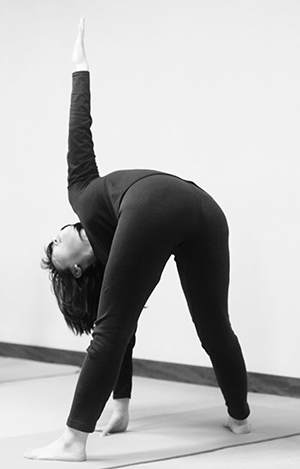Yoga’s rich heritage has allowed it to become a symbol of any number of philosophies, physical or otherwise, that have begun to redefine modern attitudes towards health and wellness, in Japan and around the world.
WHAT WE TALK ABOUT WHEN WE TALK ABOUT YOGA
If you’re looking for the “essence” of yoga, you’re in for a long history lesson. According to some scholars, it dates back to the roots of Indian civilization. You might choose, for example, to study the yoga-style postures depicted on ancient Harappan seals, and search for clues in Vedic texts and their scriptural descendants, the Upanishads, which form the basis of traditional Hindu religion and thought. This is yoga as pure physical philosophy—the body connecting to Brahma through bodily experience.
Alternatively, you could start much later (though still very long ago) with yoga sutras of the 2nd century BC, which outline the spiritual and physical practices entailed in the discipline that has come down through the ages to a world far removed from that which gave them birth. The sutras teach a style of yoga which is referred to as raja yoga. It emphasises the spiritual and mental aspects of the “eightfold path”, which includes not only a moral code of belief, but also practical instruction for the development of one’s powers of concentration, meditation, breathing, and the integration of body and spirit through physical activity, which is known as asana—the Sanskrit term meaning “to be seated.” Some modern yoga practices, such as Ashtanga Yoga, still follow the ancient practices laid out in the sutras.
Flash forward to the 15th century, Yogi Swatmarama chose to revamp the asana according to his own interpretations of the textual record, thereby pioneering the style known as hatha yoga. These asana, often translated into English as “postures,” are a physically demanding combination of stretches that increase both physical and mental flexibility and strength. This, for the most part, is yoga as we know it: an exercised-based philosophy of meditation which promises both health and, ultimately, enlightenment to the practitioner.
FROM THE BEATLES TO BIKRAM
 Although the philosophical principles of yoga were introduced to the West in the early 1900s by Swami Vivekananda, and gained some popularity in the 1930s, it wasn’t until the 1960s that yoga became a household word in the west.
Although the philosophical principles of yoga were introduced to the West in the early 1900s by Swami Vivekananda, and gained some popularity in the 1930s, it wasn’t until the 1960s that yoga became a household word in the west.
Drawn from the spiritual practices outlined in the yogic teachings Maharishi Mahesh Yogi (also the founder of Transcendental Meditation) the Beatles began to study the Maharishi’s combination of yoga and meditation. When their White Album was released, full of songs with Hindi words and references to yogic mantras, it thrust the Maharishi—and yoga—into worldwide fame. Yoga fit well into the flower-power peace movement of the time, and was imported wholesale with flowing cotton prints, patchouli, and dreadlocks.
While hatha yoga gradually gained a steady following in the west, Bikram Choudhury—an Indian yogi who began practicing yoga at the age of four, and who had become a world famous by the age of thriteen—was gradually developing his own style of yoga. While technically a branch of hatha yoga, Choudury’s style, known simply as “Bikram yoga,” is a step removed from the spiritual aspects of hatha, focusing on the physical benefits of yoga, and this is perhaps one factor that has made yoga more accessible as a form of popular physical exercise than ever before. While he originally developed his particular (and controversially copyrighted) method of 26 asana and two breathing exercises in order to overcome a weight-lifting injury, Bikram was one of the first practitioners to begin to see the possibilities that yoga had as a business. His classes, practiced in steaming hot conditions that imitate those of summer in India, have spread wildly throughout the world.
Whereas the Mahrishi maintained that he hoped merely to spread the benefits of meditation, Choudury began setting about building a veritable yogic empire. From the establishment of his first overseas studio in Los Angeles in 1973, Choudhury’s business steadily expanded, and by 2006 he was the owner of a profitable global organization of 1,600 yoga studios.
Thanks in part to this success, other yoga studios have begun mimicking Bikram yoga’s practices. So-called “hot yoga” and faster moving, “power yoga” studios have sprung up rapidly around the world. Having shaken off its granola and incense image, yoga has become glamorous and sleek—hip rather than hippy.
BIG IN JAPAN
Although Kukai, or Kōbōdaishi, the great Buddhist who is said to have contributed to so much of Japanese culture, is reported to have brought the yoga sutras to Japan in 806, yoga practice didn’t hit the mainstream in Japan until over a millennium later. While yoga had made inroads in Japan by the late 1980s, it hit a major stumbling block in 1995, when it was publicised that Aum Shinriky, the bizarre cult responsible for the Tokyo subway sarin gas attacks, practiced yoga.
For years afterwards, while yoga practice for fitness was becoming wildly popular in the West, yoga in Japan remained quietly in the background, trying to consciously avoid further notoriety and publicity.
As the century turned, however, something changed. American film stars started talking about yoga on television, and hot yoga and power yoga classes came to Tokyo. Stripped of their philosophical trappings, hot yoga and power yoga are sleek and modern, and promise to make you, the customer, that way, too.
These days, yoga is big business in Tokyo. According to research carried out in 2005-6 by economist Takashi Kadokura of the BRICs Economic Research Institute, the yoga market in Japan began to rise rapidly after 2004. From 295,000 yoga practitioners at the end of 2005, the number had reached 328,007 only six months later in mid-2006. By 2010, he has estimated that there will be over 1,220,000 yoga enthusiasts throughout Japan, possibly reaching several million by 2015. Yoga, it seems, has finally found the Japanese market, not as a philosophy, but as a product.
Traditional practitioners, that focus on improving their spiritual as well as physical flexibility, believe that this so-called “Tokyo Yoga Boom” is simply a fad. Kiyoko Hamano has been teaching yoga outside Tokyo for nearly thirty years. “I get phone calls all the time from people wanting to practice hot yoga,” she tells me. “I do traditional Indian yoga—not Hollywood yoga. This boom is like any boom: it will pass.”
Her Tuesday evening class is made up of a small group of women who range from their thirties to their seventies, and most of whom have been practicing yoga for over twenty years. They all extol the health benefits of their hobby. One long-term student tells me that she used to get sick a lot, and was constantly under the weather with colds and stomach problems. “I haven’t caught a cold since I started yoga,” she says.
Another is a badminton player, who started yoga to balance her physique. Both her arms are equally well muscled, and “I never get injured. Everyone else, they get the usual sports injuries, but I don’t.” To yoga teachers, these are classic stories, almost cliché in their regularity.
Although the popularity of power yoga and hot yoga are undeniable, Hamano believes that the idea of “power” has no place in Yoga. “Yoga—the word yoga—means ‘connection’, or ‘unity,’” she tells me. “Power doesn’t belong in this equation. The spiritual has been removed. These are only exercises.”
The popularity of yoga as “only exercise,” however, far outstrips its popularity as a spiritual practice. Nevertheless, yoga’s impressive list of health benefits have survived the transition, and any yogic practice, whether hatha or raja, hot or power or cold, still promises improved coordination, better memory, decreased blood pressure, and improved concentration.
Yoga students have reported the reduction of chronic pain, arthritis, back problems, bladder infections, and joint problems, among a long list of others. Studies and students both claim that yoga is effective against depression, and many practitioners speak proudly of improved confidence and social skills.
Despite the commercial attitudes that are seen to be characteristic of hot yoga classes, which are notoriously large and charge around ¥3,000 per 90-minute class, the promises of stress relief, weight-loss, and swift muscle toning make the classes almost irresistible.
Unlike previous exercise fads, like aerobics, for example, yoga is low-impact and accessible to almost everyone: there are maternity classes, parent and child classes, and no age limit. Another thing to remember is this: yoga has already been in practice for well over 2,000 years. If any boom has the potential to endure, this is it.
Story by Skey Hohmann
From J SELECT Magazine, May 2009















Recent Comments